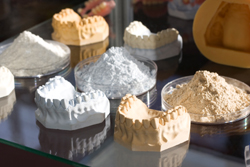Nanomaterials in dental applications
Commercial pure titanium (Ti) exhibits remarkable advantages, when compared to conventional dental alloys. In addition to biocompatibility and remarkable corrosion resistance, the abundance of this cost-effective material offers attractive alternatives for conventional dental alloys. The CATIPRO project, funded under the Fifth Framework Programme focused on the difficulties of casting Ti, which relate mainly to its high melting point and enhanced reactivity at high temperatures. Although dental laboratories use investment materials, Ti has high chemical affinity with silicon (Si) and forms a series of Si-Ti compounds. Project partner CERECO S.A. focused on the extensive contamination observed in Ti castings when SiO2-based investment materials are used. Ultimately leading to microstructure modifications, this contamination at the surface of dental Ti castings influences the corrosion and mechanical properties of the final cast work. From a clinical point of view, it increases the casting's surface roughness while reducing its fatigue limit within the highly corrosive oral environment. Elements from investment materials such as silicon (Si) and phosphorous (P) can be found in a depth of a few tenths of microns by means of scanning electron microscopy. In an attempt to minimise incoming Si and P elements, researchers replaced the conventional phosphate-bonded investment materials with new ones based on magnesia. Moreover, yttria-stabilised zirconia coatings were prepared using nanostructured and conventional powders and were applied to the surface of wax patterns to reduce the thickness of the reaction layer. The efficacy of the protective coating offers exciting new possibilities to exploit the perfect biological and mechanical properties of Ti in the field of dentistry.







